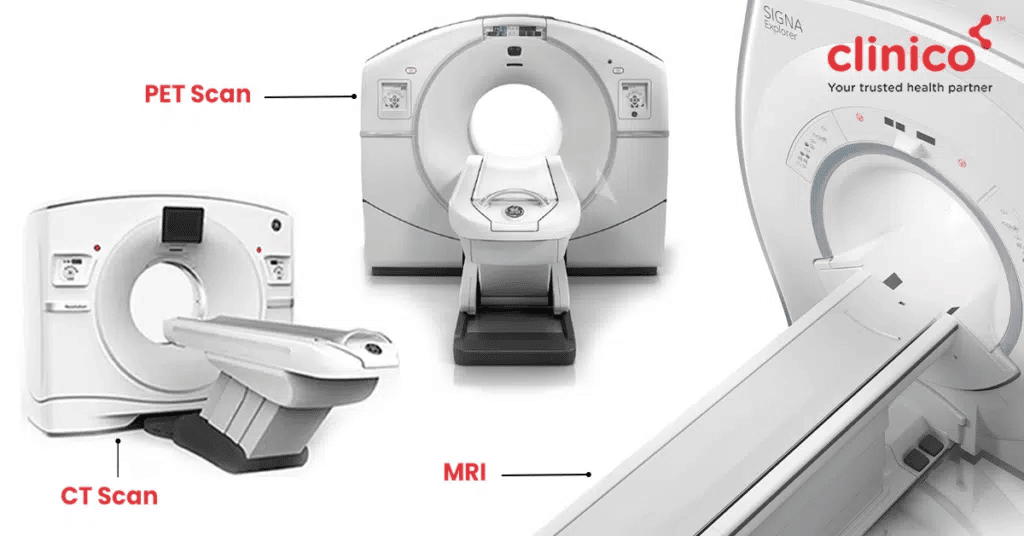
What is a PET Scan?
PET stands for Positron Emission Tomography. This scan is primarily used to identify cancer, heart disease & brain disorders like Alzheimer’s and epilepsy.
PET-CT is a combination of cross-sectional anatomic information provided by CT and the metabolic information provided by positron emission tomography (PET).
PET is most commonly performed with 2-[F-18]fluoro-2-deoxy-D-glucose (FDG). Fluorine-18 (F-18) is an unstable radioisotope and has a half-life of approximately 110 minutes.
The indications for F-18 fluorodeoxyglucose (FDG) PET-CT imaging include:
- staging of cancer which potentially can be treated radically (e.g. small cell lung cancer)
- establish baseline staging before commencing treatment (e.g. GIST)
- evaluation of an indeterminate lesion (solitary pulmonary nodule)
- assessing response to therapy
- evaluation of suspected disease recurrence, relapse and/or residual disease (e.g. lymphoma, testicular seminoma).
- Baseline FDG-PET/CT detects bone marrow involvement in follicular lymphoma and provides relevant prognostic information
- to guide a biopsy (e.g. pleural biopsy for mesothelioma)
PET-CT can also be used as a problem-solving tool:
- occult primary lesion (e.g. non-metastatic manifestation of neoplastic disease)
- evaluation of suspected recurrence in patients with equivocal conventional imaging
- evaluation of residual disease in patients with treated differentiated thyroid carcinoma and treated medullary thyroid carcinoma with negative/equivocal conventional imaging
- prior to radical nodal resection in patients with metastatic melanoma
- differentiate between radiation-induced necrosis and tumor recurrence (e.g. primary CNS malignancy)
Types of Radiotracers
There are many different types of radiotracers. However, the most commonly used include:
- 18F-FDG PET-CT scan- mainly used in oncology, myocardial viability and to diagnose dementia, epilepsy.
- 18F-NaF- BONE PET -CTscan- to evaluate bone metastases and other bone diseases.
- 18F-PSMA PET –CT Scan- for diagnosing, staging, early biochemical recurrence after surgery and surveillance of the prostate cancer.
- 18F-DOPA scan- to diagnose demntia, alzheimers disease.
What is a CT Scan?
To put it in simple terms, a Computerized Tomography (CT) scan uses multiple X-rays from different angles & positions to generate a 3D image, as opposed to a traditional X-ray which produces a standard 2D image.
CT scans are typically used to scan for infections, tumours and detect cancer before it has spread & grown and identify internal bleeding.
The drawback of CT scans is similar to that of X-rays: they use radiation which implies that a patient cannot get multiple CT scans done in a short span without risk.
What is a MRI Scan?
In contrast to X-rays and CT scans, MRI (Magnetic Resonance Imaging) doesn’t involve the use of potentially harmful ionising radiation. Instead, an MRI scan consists of a combination of radio waves & magnets to generate a detailed, cross-sectional image that helps diagnose injuries and other problems within a human body.
MRIs are regularly used to evaluate infections and tumours. Sports injuries are also detected as they are particularly effective in diagnosing broken bones and torn ligaments.
How is PET Scan different from CT Scan & MRI Scan?
Coming to the main topic, let’s check out how a PET scan is different from a CT scan or MRI.
| PET Scan | CT Scan | MRI Scan |
| Use a Radioactive Tracer | Use X-rays | Use Magnets & Radio Waves |
| Generate still and 3D colour images of the radiotracer distribution within the human body | Generate still and 3D images of organs & body structures | Generate still images of organs & body structures |
| Detect cellular changes in organs & tissues earlier than CT & MRI scans | Detect cellular changes in organs & tissues slower than PET scan | Detect cellular changes in organs & tissues slower than PET scan |
Conclusion
To sum it up, all three scans differ in their work and usage. Each has its advantages & drawbacks and should only be done on the recommendation of a healthcare professional. Radiologist is the right person to guide for the right usage of the modality.
Are you looking to get any of these three scans done?
Clinico is at your service!
One of Mumbai’s highly rated diagnostic chains and an established NABL certified brand, we offer excellent diagnostic & pathology services in Mulund, Bhandup, Thane & Navi Mumbai.
Schedule Your MRI / CT Scan / PET –CT Scan Now! Contact us 24×7 on 9504555555.
FAQ’s
Mantaka, Panagiota, et al. “PET with 2-[F-18]-fluoro-2-deoxy-D-glucose (FDG) in patients with cancer of unknown primary (CUP): influence on patients’ diagnostic and therapeutic management.” Cancer Biotherapy and Radiopharmaceuticals 18.1 (2003): 47-58.
https://www.liebertpub.com/doi/abs/10.1089/108497803321269322
Leboulleux, Sophie, et al. “Medullary thyroid carcinoma.” Clinical endocrinology 61.3 (2004): 299-310.
https://onlinelibrary.wiley.com/doi/abs/10.1111/j.1365-2265.2004.02037.x

